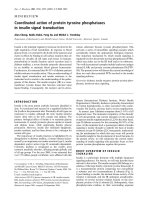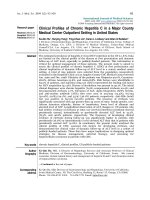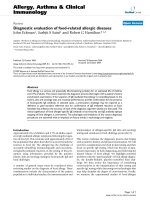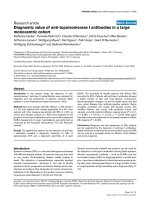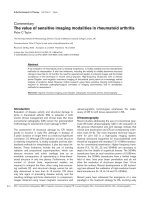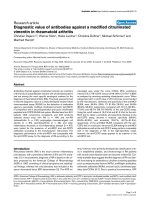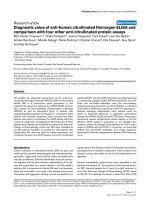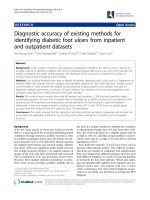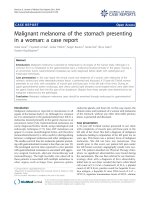Báo cáo y học: "Diagnostic value of anti-topoisomerase I antibodies in a large monocentric cohort" pdf
Bạn đang xem bản rút gọn của tài liệu. Xem và tải ngay bản đầy đủ của tài liệu tại đây (325.47 KB, 10 trang )
Open Access
Available online />Page 1 of 10
(page number not for citation purposes)
Vol 11 No 1
Research article
Diagnostic value of anti-topoisomerase I antibodies in a large
monocentric cohort
Katharina Hanke
1
, Cornelia Dähnrich
2
, Claudia S Brückner
1
, Dörte Huscher
3
, Mike Becker
1
,
Anthonina Jansen
2
, Wolfgang Meyer
2
, Karl Egerer
1
, Falk Hiepe
1
, Gerd R Burmester
1
,
Wolfgang Schlumberger
2
and Gabriela Riemekasten
1
1
Department of Rheumatology and Clinical Immunology, Charité Universitätsmedizin Berlin, Charitéplatz 1, Berlin 10117, Germany
2
EUROIMMUN Medizinische Labordiagnostika AG, Seekamp 31, Lübeck 23560, Germany
3
German Rheumatism Research Centre, Charitéplatz 1, Berlin 10117, Germany
Corresponding author: Gabriela Riemekasten,
Received: 8 Sep 2008 Revisions requested: 20 Oct 2008 Revisions received: 21 Jan 2009 Accepted: 21 Feb 2009 Published: 21 Feb 2009
Arthritis Research & Therapy 2009, 11:R28 (doi:10.1186/ar2622)
This article is online at: />© 2009 Hanke et al.; licensee BioMed Central Ltd.
This is an open access article distributed under the terms of the Creative Commons Attribution License ( />),
which permits unrestricted use, distribution, and reproduction in any medium, provided the original work is properly cited.
Abstract
Introduction In the present study, the detection of anti-
topoisomerase I (anti-topo I) autoantibodies was evaluated for
diagnosis and risk assessment of systemic sclerosis (SSc)
patients in a well characterized large monocentric cohort.
Methods Sera from patients with SSc (diffuse n = 96, limited n
= 113), from patients with overlap syndromes (n = 51), from
patients with other diseases associated with SSc (n = 20), as
well as from disease controls (n = 487) were analysed for the
presence of anti-topo I antibodies by line immunoblot assay and
ELISA. Assessment of organ manifestations was performed as
proposed by the European Scleroderma Trial and Research
network.
Results The applied test systems for the detection of anti-topo
I antibodies revealed a diagnostic sensitivity for SSc of
approximately 24% and a diagnostic specificity of at least
99.6%. The sensitivity to identify patients with diffuse SSc
amounted to 60%. Patients with anti-topo I antibodies showed
a higher burden of skin and lung fibrosis, contractures,
electrocardiogram changes, as well as digital ulcers and had
more active disease than antibody-negative patients. Signal
strengths correlated only weakly with disease activity, with
modified Rodnan skin score, with predicted forced vital
capacity, and with predicted diffusion capacity levels (P = 0.01,
= 0.234, = 0.413, = -0.215, = -0.219). High signal
intensities were associated with an increased mortality in diffuse
SSc patients (P = 0.003).
Conclusions Diagnosis and risk assessment of SSc patients
can be supported by the detection of anti-topo I antibodies.
Signal intensities as obtained by line immunoblot assay or ELISA
can be used as a surrogate marker for fibrosis, active disease
and worse prognosis.
Introduction
Systemic sclerosis (SSc) is a rare and heterogeneous disease
with different disease subsets. Its outcome may vary from mild
to very severe, life-threatening disease rapidly leading to
death. The detection of autoantibodies, especially directed
towards topoisomerase I (anti-topo I), can help to identify
patients at risk for progressive and severe disease and to clas-
sify them according to their disposition for certain clinical man-
ifestations [1-6]. Depending on the studies, however, antibody
frequencies varied between 14% [2] and 70% [4].
Several commercially available test systems can be used for
the detection of anti-topo I antibodies. Among these systems,
efficient monospecific methods – such as ELISAs and line
immunoblot assays (LIAs) for single-parameter or profile anal-
ysis – have been established in clinical laboratory practice dur-
ing past years, allowing examination of a large number of sera
in a rapid approach at high sensitivity and at high specificity [7-
10].
anti-topo I: anti-topoisomerase I; DLCO: predicted diffusion capacity; DNSS: Deutsches Netzwerk (German Network) of Systemic Scleroderma;
ELISA: enzyme-linked immunosorbent assay; EUSTAR: European Scleroderma Trial and Research; FVC: predicted forced vital capacity; LIA: line
immunoblot assay; mRSS: modified Rodnan skin score; SSc: systemic sclerosis.
Arthritis Research & Therapy Vol 11 No 1 Hanke et al.
Page 2 of 10
(page number not for citation purposes)
The precise clinical characterization of the patients and their
assessment are crucial for the evaluation of a new assay or of
a potential biomarker such as anti-topo I antibodies as well as
for the comparison with other studies. As shown before, differ-
ences in the frequencies of anti-topo I antibodies in different
studies might be caused by ethnic background [1,11] or by
different classification systems of SSc [1,2,12-14]. Most stud-
ies have used the American College of Rheumatology classifi-
cation criteria [1,2,13]; however, there are some limitations
especially for early and probably very late cases, as these cri-
teria were originally not intended to be used as a diagnostic
tool. Other studies have divided their patients into diffuse, lim-
ited, and intermediate SSc patients or have included overlap
syndromes [13,14]. In recent years, the LeRoy criteria for clas-
sification have been widely used. In this classification system,
however, the presence of anti-topo I antibodies is often asso-
ciated with diffuse SSc [15].
Most studies have shown that anti-topo I-positive patients suf-
fer more frequently from severe lung and skin fibrosis
[4,6,13,16]. Several studies have identified further associa-
tions not confirmed by others while using different assessment
strategies to define organ involvement or disease activity
[17,18]. Additionally, the interval between the detection of
antibodies and the clinical assessment often remains unspec-
ified [1]. National and multinational networks such as the Euro-
pean Systemic Sclerosis Trial and Research (EUSTAR)
network or the German Network of Systemic Sclerosis
(DNSS) addressed the standardization in the assessment and
classification of patients. Despite these efforts, both intraob-
server variability and interobserver variability are still signifi-
cant, especially when multicentric studies are performed [19].
In the present cross-sectional monocentric study, we analysed
a large cohort of genuine SSc patients, patients with diseases
related to SSc as well as numerous disease controls for the
presence and diagnostic impact of anti-topo I antibodies
detected by means of commercially available, monospecific
LIA and ELISA. In order to minimize limitations of former stud-
ies, clinical data were assessed simultaneously to antibody
detection by a standardized procedure with only a limited
number of investigators.
Materials and methods
Classification of patients
Sera from 280 consecutive patients with SSc were tested for
the presence of anti-topo I antibodies. As disease controls we
included serum samples from patients with myositis (n = 26),
from patients with systemic lupus erythematosus (n = 208),
from patients with Sjögren's syndrome (n = 88) and from
patients with rheumatoid arthritis (n = 165). All patients were
diagnosed at the Charité University of Medicine (Berlin,
Germany).
Classification of SSc patients was performed before starting
the study based on the maximal skin involvement during the
disease course, on the basis of the LeRoy criteria and accord-
ing to the EUSTAR and DNSS criteria [20]. Briefly, SSc
patients were classified as having either limited SSc or diffuse
SSc depending on the distribution of skin sclerosis below or
above the elbows, knees or clavicles [15]. Once classified as
having diffuse SSc, the patient remains classified as having
diffuse SSc. Characteristics of SSc patients are presented in
Table 1.
Overlap syndrome was defined as a disease occurring with
clinical aspects of SSc (according to the American College of
Rheumatology criteria) or with the main symptoms of SSc
simultaneously with those of other connective tissue diseases/
other autoimmune diseases, such as dermatomyositis, Sjö-
gren's syndrome or systemic lupus erythematosus. These
patients are mostly positive for anti-U1-RNP antibodies or anti-
PM-Scl antibodies [21,22]. SSc sine scleroderma was
defined by the lack of skin alterations in the presence of other
SSc symptoms [23]. Undifferentiated connective tissue dis-
ease with scleroderma features was defined as positive Ray-
naud's phenomenon and at least one further feature of SSc
and/or detectable scleroderma-associated autoantibodies
[24].
Assessment of systemic sclerosis patients
With the exception of the subclassification of SSc patients,
clinical data were collected simultaneously at the time sera
were obtained for the detection of anti-topo I antibodies. Most
patients were assessed by one investigator (GR), and the sec-
ond investigator involved (CB) was instructed by the first
investigator. Both investigators participated in several training
programs of EUSTAR and DNSS for the assessment of SSc
patients.
The modified Rodnan Skin Score (mRSS) was used for the
evaluation of fibrotic skin changes [25,26]. Cardiac involve-
ment was defined by the presence of two of the following
symptoms: diastolic dysfunction, conduction abnormalities,
cardiomyopathy, or reduced ejection fraction unrelated to
other diseases, valvular changes such as tricuspidal insuffi-
ciency not explained for by other causes than SSc, or pericar-
ditis. Conduction blocks and signs of atrial and ventricular
hypertrophy related to SSc were summarized as electrocardi-
ogram changes. Disease activity was obtained using the EUS-
TAR activity index [17]. Pulmonary arterial hypertension was
defined by a mean pulmonary arterial pressure of 25 mmHg at
rest and 30 mmHg at exercise when assessed by right heart
catheterization or by the presence of pulmonary artery systolic
pressure 40 mmHg as detected by echocardiography and
signs of right heart failure. Pulmonary fibrosis was diagnosed
by chest radiogram and/or by high-resolution computed tom-
ography scans. Lung function was assessed by the predicted
forced vital capacity (FVC) and the predicted diffusion
Available online />Page 3 of 10
(page number not for citation purposes)
capacity (DLCO) by a single breath method. Renal involve-
ment was diagnosed by present or past renal crisis or impaired
kidney function unexplained by other causes. Digital ulcers
were defined as a loss of both epidermis and dermis in an area
of at least 2 mm diameter at the distal phalanx of fingers.
Patients were included in the study between January 2004
and May 2007. For a prospective survival analysis, patients
were observed for a mean period of 24.6 months (18 to 52
months). To assess cumulative survival data from the time
point of diagnosis, primary care doctors or patients were con-
tacted in order to monitor survival and treatment in patients
without regular appointments.
Table 1
Clinical and demographic characteristics of the systemic sclerosis (SSc) cohort (Charité University)
Diffuse SSc Limited SSc SSc sine
scleroderma
Overlap Mixed
connective
tissue disease
Undifferentiated
connective tissue
disease
All patients
Anti-
topoisomerase I
(LIA)
58 (60.4) 7 (6.2) 1 (25.0) 1 (2.6) 0 0 67 (23.9)
Anti-
topoisomerase I
(ELISA)
57 (59.4) 6 (5.3) 1 (25.0) 1 (2.6) 0 0 65 (23.2)
Number 96 113 4 38 13 16 280
Age (years) 53 ± 14.5 60 ± 11.3 54 ± 12.7 52 ± 13.3 52 ± 13.5 56 ± 10.7 56 ± 13.2
Duration of
Raynaud's
phenomenon
(years)
9 ± 10.6 14 ± 13.6 18 ± 18.47 8 ± 7.4 16 ± 10.4 11 ± 9.3 12 ± 11. 6
Duration of non-
Raynaud's
phenomenon
symptoms
7.8 ± 1.6 9.5 ± 1.39 6 ± 10.8 8.8 ± 2.2 9.1 ± 5.5 9.3 ± 6.3 8.7 ± 7.6
Duration since
disease diagnosis
(years)
6 ± 7.38 8 ± 7.4 3 ± 2.6 6 ± 5.17 9.1 ± 5.5 7 ± 7.28 7 ± 7.38
Female/male 79/17 105/8 2/2 28/10 13/0 16/0 243/37
mRSS 13.2 ± 9.6 5.2 ± 4.2 1.5 ± 1.1 6.7 ± 7.5 1.6 ± 1.8 0.8 ± 1.1 7.6 ± 8.0
Digital ulcers 52 (54.2) 38 (33.6) 2 (50) 14 (36.8) 4 (30.8) 2 (12.5) 112 (40.0)
Lung fibrosis 57 (59.4) 16 (14.2) 3 (75) 16 (42.1) 4 (30.8) 2 (12.5) 98 (35.0)
DLCO by a single
breath (%)
64.9 ± 21.9 76,8 ± 17.5 56.6 ± 12.8 64.2 ± 22.4 75.3 ± 17.8 75.4 ± 17.1 70.5 ± 20.5
Mean FVC (%) 81.7 ± 18.93 96.7 ± 15.2 87.5 ± 30.7 84.0 ± 19.2 92.9 ± 23.5 92 ± 18.0 89,2 ± 19.
Contractures 78 (81.3) 62 (54.9) 2 (50) 23 (60.5) 4 (30.8) 3 (18.8) 172 (61.4)
Pulmonary arterial
hypertension
22 (22.9) 22 (19.5) 2 (50) 9 (23.7) 4 (30.8) 1 (6.3) 60 (21.4)
Renal
involvement
17 (17.7) 22 (19.5) 1 (25) 10 (26.3) 4 (30.8) 2 (12.5) 56 (20)
Renal crisis 10 (10.4) 3 (2.7), n = 112 1 (25) 1 (2.6) 0 1 (6.3) 16 (5.7), n =
279
Cardiac
involvement
47 (49.0) 35 (31.0) 3 (75) 19 (50) 6 (46.2) 4 (25) 117 (40.7)
Skin involvement 94 (98.9) 105 (92.9) 3 (75) 32 (84.2) 7 (53.8) 7 (43.8) 248 (88.9)
Raynaud's
phenomenon
95 (99) 110 (97.3) 4 (100) 38 (100) 12 (92.3) 13 (81.3) 272 (97.1)
Data presented as mean ± standard deviation or n (%). DLCO, predicted diffusion capacity; FVC, predicted forced vital capacity; LIA, line
immunoblot assay; mRSS, modified Rodnan Skin Score.
Arthritis Research & Therapy Vol 11 No 1 Hanke et al.
Page 4 of 10
(page number not for citation purposes)
The study was approved by the local ethical committee (EA1/
013/705). Written informed consent was obtained from each
patient.
Antibody detection
Sera from consecutive patients with SSc-related diseases as
well as sera serving as disease controls were obtained simul-
taneously with the clinical assessment of the patients and
were stored at -20°C. Anti-topo I antibodies were detected by
commercially available, CE-certified monospecific LIA (Anti-
Scl-70 EUROLine) and ELISA (Anti-Scl-70 ELISA) provided
by EUROIMMUN AG (Lübeck, Germany). Blot strips and
ELISA wells are coated with commercial Scl-70 antigen puri-
fied by affinity chromatography from bovine thymus (>90%
purity). This antigen (molecular weight 75 to 82 kDa) repre-
sents a proteolytic degradation product of the predominant in
vivo form of the enzyme DNA topoisomerase I (molecular
weight 100 kDa); both the native and lower molecular weight
forms have been shown to effectively bind autoantibodies
against topoisomerase I [27]. Antigen reactivity of LIA and
ELISA was verified using the human reference serum CDC-
ANA #9 (Center for Disease Control, Atlanta, GA, USA) and
both test systems were validated thoroughly using well char-
acterized positive and negative controls.
All analyses were performed according to the manufacturer's
instructions and were carried out blindly by personnel unaware
of the diagnosis and the clinical characteristics of the patients.
For the LIA, human sera were diluted 1:101 prior to use and
antibody detection was performed using alkaline phos-
phatase-labelled goat anti-human IgG. Control sera were
included in each assay. Incubated blot strips were digitalized
using a flatbed scanner. The intensity of the bands was auto-
matically evaluated by a computer program. Signal strengths
above 6 units were considered positive, as recommended by
the manufacturer.
With respect to the ELISA, all serum samples were analysed
at a dilution of 1:201 in parallel with control sera. Peroxidase-
labelled rabbit anti-human IgG served as the secondary anti-
body conjugate. For evaluation, data above the cut-off value of
20 units/ml were considered positive, complying with the man-
ufacturer's recommendation.
Statistical analysis
The dataset was analysed using the SPSS V 15.0 statistical
package (NASDAQ, Bloomingdale, IL 60108, USA) and the
Microsoft calculation software Excel V 12 (2007; Microsoft
corporation, USA). To identify associations between SSc
symptoms and the occurrence of anti-topo I antibodies, chi-
square tests, Mann–Whitney U tests, and Wilcoxon signed-
rank tests were performed when appropriate. Spearman's rank
correlation coefficient () was applied to analyse possible cor-
relations. For all tests, P < 0.05 was considered statistically
significant.
Results
Diagnostic sensitivity and specificity of anti-
topoisomerase I antibody detection and identification of
SSc patients with diffuse disease
Using the monocentric SSc cohort (n = 280) and four disease
control cohorts (n = 487), the detection of anti-topo I antibod-
ies revealed a diagnostic sensitivity for SSc of 23.9% (23.2%)
and a diagnostic specificity of 99.6% (99.8%), as determined
by LIA (ELISA) (Table 2). In general, a significant correlation
was observed between LIA signal strengths and antibody lev-
els as detected by ELISA (P < 0.0005, = 0.752; Figure 1).
Since the SSc cohort was rather heterogeneous, the fre-
quency of anti-topo I antibodies was determined for the dis-
tinct patient groups and disease manifestations, resulting in
sensitivities and specificities for the serological identification
of these clinical characteristics with reference to the SSc
cohort (Table 2 and Table 3). LIA analyses revealed the pres-
ence of anti-topo I antibodies in 58 (60.4%) out of 96 patients
with diffuse SSc. In contrast, only seven (6.2%) out of 113
patients with limited SSc, just one among 38 patients with an
overlap syndrome other than mixed connective tissue disease
and only one out of four patients with SSc sine scleroderma
were positive for anti-topo I antibodies. Identical results were
obtained by means of ELISA, with the exception of only 57
(59.4%) anti-topo I-positive patients with diffuse SSc and six
positive results (5.3%) in the group of limited SSc. Based on
these data, detection of anti-topo I antibodies by means of LIA
(ELISA) revealed a sensitivity for diffuse SSc of 60.4%
(59.4%) with a specificity of 95.1% (95.6%), referring to the
cohort of 280 patients with SSc.
Moreover, LIA signal strengths were stronger in diffuse SSc
patients compared with limited SSc patients. The mean signal
intensity was 148.4 units (standard deviation = 4.4) in diffuse
SSc patients and 103.6 units (standard deviation = 24.5) in
limited SSc patients (P < 0.0005), supporting the quantitative
data obtained by ELISA (data not shown). With the ELISA,
patients with diffuse SSc had higher mean values (467.6
units/ml, standard deviation = 68.1) when compared with
patients with limited SSc (233.2 units/ml, standard deviation
= 97.3, P < 0.0005).
Owing to the substantial degree of diagnostic conformity
between LIA and ELISA (reflected by the above presented
data and the data not shown), only results obtained by LIA are
presented in the following sections.
Available online />Page 5 of 10
(page number not for citation purposes)
Anti-topoisomerase I antibodies were associated with
peripheral vascular complications but not with
pulmonary arterial hypertension or renal crisis
Patients with anti-topo I antibodies revealed a higher fre-
quency of present or past digital ulcers (Table 3): 57% of the
anti-topo I-positive patients suffered from present or past dig-
ital ulcers. In patients without anti-topo I antibodies, the preva-
lence of digital ulcers was significantly lower (32.2%).
In contrast, there was no association between the presence of
anti-topo I antibodies and pulmonary arterial hypertension or
renal involvement including renal crisis. There was also no
association between the presence of anti-topo I antibodies
and neuropathies, heart (despite conduction disturbances)
and gastrointestinal involvement, renal involvement, sicca syn-
drome, joint involvement, or any other clinical symptom
assessed by the EUSTAR and DNSS core dataset (data not
shown) [16,28].
Anti-topoisomerase I antibodies characterize patients
with fibrotic SSc features and active disease
Among the 280 patients with SSc, anti-topo I-positive patients
were characterized by fibrotic signs of SSc. As detected by
LIA, anti-topo I-positive patients had a significantly higher prev-
alence of lung fibrosis (68.6%) when compared with the anti-
topo I-negative group (23.3%). In addition, patients with anti-
topo I antibodies had a lower predicted FVC when compared
with the anti-topo I-negative SSc group (Tables 1 and 3). Only
15.6% of the patients with a predicted FVC > 85% had anti-
topo I antibodies, but 55% of the patients with a FVC of 50%
to 69% had anti-topo I antibodies (Figure 2). The association
between the group of predictive FVC and the presence of anti-
topo I antibodies was significant (P = 0.006).
Similar results were obtained for the predicted DLCO by a sin-
gle breath. Patients with anti-topo I antibodies had a lower pre-
dicted DLCO when compared with antibody-negative patients
(Table 3). Of the patients with a predicted DLCO > 85%,
15.5% were anti-topo I-positive; in contrast, the frequency of
patients with anti-topo I antibodies increased to 43.8% in
patients with DLCO < 35% (Figure 2). Again, the groups of
DLCO levels were significantly related to the presence of anti-
topo I antibodies (P < 0.001). Patients with anti-topo I antibod-
ies also had a higher mRSS compared with patients without
Table 2
Sensitivity and specificity of anti-topoisomerase I antibodies
Panel n Line immunoblot assay ELISA
Diffuse systemic sclerosis
a
96 58 (60.4%) 57 (59.4)
Limited systemic sclerosis
a
113 7 (6.2%) 6 (5.3%)
Systemic sclerosis sine scleroderma
a
4 1 (25%) 1 (25%)
Overlap
a
38 1 (2.6%) 1 (2.6%)
Mixed connective tissue disease
a
13 0 0
Undifferentiated connective tissue disease
a
16 0 0
Sensitivity
a
280 67 (23.9%) 65 (23.2%)
Myositis
b
26 0 (100%) 0 (100%)
Systemic lupus erythematosus
b
208 0 (100%) 0 (100%)
Sjögren's syndrome
b
88 0 (100%) 0 (100%)
Rheumatoid arthritis
b
165 2 (98.8%) 1 (99.4%)
Specificity
b
487 2 (99.6%) 1 (99.8%)
a
Data presented as number of patients positive in the respective test (percentage within the respective patient cohort).
b
Data presented as
number of patients positive in the respective test (percentage of negative results within the respective control cohort).
Figure 1
Line immunoblot assay signal strengths and logarithmized ELISA values to detect anti-topoisomerase I antibodiesLine immunoblot assay signal strengths and logarithmized ELISA values
to detect anti-topoisomerase I antibodies. Correlation between line
immunoblot assay (LIA) signal strengths and logarithmized ELISA val-
ues for the detection of anti-topoisomerase I antibodies in our cohort of
280 patients. The logarithmic curve as indicated by the Spearman cor-
relation coefficient reflects the correlation better than a linear correla-
tion (as shown by the line). ab, antibody; U, units.
Arthritis Research & Therapy Vol 11 No 1 Hanke et al.
Page 6 of 10
(page number not for citation purposes)
anti-topo I antibodies (Table 3). Only 2.2% of patients with a
mRSS between 0 and 3 had anti-topo I antibodies. In contrast,
61.4% of the patients with a mRSS > 14 were anti-topo I anti-
body-positive (Figure 2). The higher the skin score, the higher
the probability of being anti-topo I-positive (P < 0.001).
Patients with anti-topo I antibodies had a higher prevalence of
tendon friction rubs that could be interpreted as a sign of
active disease. Furthermore, anti-topo I antibodies were asso-
ciated with contractures and electrocardiogram changes
(Table 3).
Anti-topoisomerase I-positive patients showed a higher
disease activity and mortality
The SSc activity score was available for 266 out of 280
patients. Patients with anti-topo I antibodies as detected by
LIA revealed a higher disease activity score when compared
with antibody-negative SSc patients (Table 3). There was also
a weak correlation between disease activity and signal
strengths determined by LIA (P = 0.01, = 0.234). The corre-
lation was slightly better for patients with diffuse SSc. Here,
the Spearman's rank correlation coefficient was 0.237 for the
correlation between disease activity and LIA data (data not
shown).
After serum withdrawal for antibody detection, all patients
were followed up for a mean period of 24.6 months. During
this period, 16 SSc patients of our cohort died on average 7
years after diagnosis – 14 patients from SSc-associated com-
plications, two patients from malignancies. In diffuse SSc
patients, there was a low overall cumulative mortality. Eight
patients of the diffuse SSc group died, and five of these
patients were anti-topo I antibody-positive, revealing no signif-
icant differences between the anti-topo I-positive and anti-
topo I-negative patients. The presence of anti-topo I antibodies
was important for early mortality (P = 0.03; Figure 3a), how-
ever, especially when high signal strengths above 150 units
were studied in the diffuse subset of SSc patients (P = 0.003;
Figure 3b).
Signal strengths in line immunoblot assay correlated
with the extent of skin and lung fibrosis
LIA signals correlated to the extent of skin and lung fibrosis.
There was a weak but significant correlation between the LIA
signal strengths and mRSS values (P = 0.01, = 0.413). Fur-
thermore, the signal strengths correlated negatively with the
predicted DLCO values by a single breath (P = 0.01, = -
0.219) and with the predicted FVC values (P = 0.01, = -
0.215).
Table 3
Anti-topoisomerase I antibody-positive versus antibody-negative patients in systemic sclerosis cohort assessed by line
immunoblot assay
Disease manifestation Patients with disease
manifestation
Anti-topoisomerase I P value Sensitivity (%) Specificity (%)
Positive (n = 67) Negative (n = 213)
Digital ulcers 112 (40.0%) 38 (56.7%) 74 (34.7%) 0.002 33.9 82.7
Lung fibrosis 98 (35.0%) 46 (68.6%) 52 (24.4%) <0.0005 46.9 88.5
DLCO by a single breath 62.9 ± 20.8 72.9 ± 19.9 <0.0005 NA NA
Mean FVC 81.1 ± 18.0 91.8 ± 18.7 <0.0005 NA NA
Pulmonary arterial
hypertension
60 (21.4%) 17 (25.4%) 43 (20.2%) 0.39 28.3 77.3
Contractures 162 (57.9%) 59 (88.1%) 113 (53.1%) <0.0005 34.3 92.6
Renal involvement 56 (20.0%) 13 (19.4%) 43 (20.2%) 1 23.2 75.9
Renal crisis 16 (5.7%) 6 (9%) 10 (4.7%) 0.23 37.5 76.8
Cardiac involvement 114 (40.7%) 33 (49.2%) 81 (38.0%) 0.12 28.9 79.5
Conduction blocks 69 (24.6%) 25 (37.3%) 44 (20.7%) 0.009 36.2 80.1
Electrocardiogram changes 74 (26.4%) 27 (40.3%) 47 (22.1%) 0.007 36.5 80.4
mRSS 14.2 ± 10.2 5.57 ± 5.8 <0.0005 NA NA
Raynaud's phenomenon 272 (97.1%) 67 (100%) 205 (96.2%) 0.2 24.6 100
Diffuse systemic sclerosis 96 (34.3%) 58 (86.6%) 38 (17.8%) <0.0005 60.4 95.1
Mean disease activity 2.49 1.63 <0.0005 NA NA
Data presented as n (%) or mean ± standard deviation. DLCO, predicted diffusion capacity; FVC, predicted forced vital capacity; mRSS, modified
Rodnan skin score; NA, not applicable.
Available online />Page 7 of 10
(page number not for citation purposes)
Discussion
The present study demonstrates the diagnostic significance of
anti-topo I autoantibodies for clinical assessment of SSc
patients in a large monocentric cohort. Antibody detection
was performed by means of two commercial test systems, LIA
and ELISA, both of which equally identified patients with active
diffuse SSc with a higher burden of skin and lung fibrosis,
electrocardiogram changes, digital ulcers, and contractures.
Importantly, detected signal strengths correlated with skin
score values, lung function parameters, and disease activity.
We also showed a negative correlation between the predicted
DLCO levels and the levels of anti-topo I antibodies, to our
knowledge not identified by other studies, suggesting that the
decline of DLCO in anti-topo I-positive patients is associated
with lung fibrosis. Additionally, high signal strengths were
associated with increased mortality in the diffuse SSc
patients, indicating the potential of the applied test systems to
identify patients with a more severe form of diffuse SSc.
Our cohort is part of the EUSTAR network and, compared with
the EUSTAR patients, our anti-topo I-positive SSc patients
showed similar clinical data, such as mean mRSS, age, dis-
ease duration, frequency of lung fibrosis, pulmonary arterial
hypertension, and percentages of predicted DLCO [16]. In
line with this correlation, the frequency of anti-topo I-positive
patients was nearly identical – with 60.4% in our cohort com-
pared with 60.8% in the EUSTAR cohort. For the EUSTAR
database, the test used to identify anti-topo I antibodies is not
defined and each centre is free to use the method most avail-
able. Our results support the conclusion that LIA or ELISA can
be used similarly to other assays without loss of information.
Furthermore, the similarities of our cohort with the European
databank suggest that our cohort of SSc patients is represent-
ative for European SSc patients. Nevertheless, the frequency
of anti-topo I antibodies is much higher than found in other
cohorts, such as the Pittsburgh cohort with a frequency of
26% among diffuse SSc patients [6]. In their cohort, anti-topo
I antibodies were detectable in 25% of the patients with lim-
ited SSc [1], representing a contrast to the low frequency of
6.2% in our 113 limited SSc patients.
In our monocentric cohort, most patients have suffered from
SSc for longer than 6 years (Table 1). At the time of the
present study, patients were already classified according to
their maximal skin sclerosis. According to the DNSS and EUS-
TAR assessment strategy, the subclassification does not
change – independent of the current distribution of skin scle-
rosis. Since LeRoy classification criteria are easily applicable
to the extremes of limited SSc and diffuse SSc, there are
patients between these typical SSc features. In those patients
between these features, access to antibody levels, disease
course, and organ manifestations could be helpful to classify
the disease. We assume that the number of patients with cur-
rent limited SSc is higher even in the anti-topo I antibody-pos-
itive patients. This could explain differences in the prevalence
of anti-topo I antibodies among limited SSc patients. Further-
more, differences in the subclassification, antibody status, and
clinical associations could be confounded by different ethnic
backgrounds [11,29]. In our study, the population of anti-topo
I-positive patients was almost homogeneously Caucasian.
Only six patients in the anti-topo I-negative cohort had a differ-
ent genetic background. By deleting these genetically differ-
ent patients, the results of statistical analyses did not become
different. Taking these factors together, in the present study
the classification of the SSc patients into diffuse SSc and lim-
ited SSc was not done exclusively by measuring the current
distribution of skin sclerosis. We also were aware of the
autoantibody findings and the previous course of disease that
can be critically discussed. A limitation of the present study is
therefore a possible overestimation of diffuse SSc patients in
our cohort. As recently published by our group analysing a
large cohort of more than 1,000 German SSc patients, how-
ever, skin sclerosis is only of limited value to identify SSc
patients with severe organ manifestations [30].
As shown by other studies using much larger cohorts, anti-
topo I antibodies characterize patients with a higher extension
of skin and lung fibrosis [1,6,13,16]. Other studies have also
identified associations between the presence of anti-topo I
antibodies with digital ulcers and with arthritis not confirmed
by other works [6,30,31]. Furthermore, the assessment of the
organ involvement seems to be crucial and often varies in dif-
ferent studies. When cardiac involvement is studied, different
definitions are used. One group defined cardiac involvement
by the presence of pericarditis or conduction disturbances of
nonischaemic origin, and identified an association between
Figure 2
Detection of anti-topoisomerase I antibodies by line immunoblot assayDetection of anti-topoisomerase I antibodies by line immunoblot assay.
Detection of anti-topoisomerase I (anti-topo I) antibodies by line immu-
noblot assay with respect to different levels of predicted diffusion
capacity (DLCO) by a single breath (%), predicted forced vital capacity
(FVC) (%) and modified Rodnan skin score (mRSS) values in 280
patients with systemic sclerosis (SSc) and diseases related to SSc.
Numbers in bars, absolute counts. P values are results of the chi-
square test. *For the chi-square test, because of the low case numbers
in the last group, the last two mRSS groups were joined to hold the test
assumptions (maximum 20% of cells have expected cell count < 5).
Arthritis Research & Therapy Vol 11 No 1 Hanke et al.
Page 8 of 10
(page number not for citation purposes)
cardiac involvement and the presence of anti-topo I antibodies
– supporting the results from our study [5]. Another group
defined heart involvement by symptomatic pericarditis, con-
gestive heart failure, or arrhythmias requiring treatment and did
not find any association with the serological status [6]. Since
the assessment of subjective symptoms can be influenced by
different reasons, and – as shown especially for the therapy of
arrhythmias – guidelines and treatment modalities may vary,
there is a need to use objective parameters to identify involve-
ment of specific organs. International consensus criteria for
assessment would be important for the evaluation of a poten-
tial biomarker and also to identify differences in the prevalence
of organ involvement, but have so far not been established. In
this setting, large monocentric cohorts with a homogeneous
assessment could provide the most valuable data.
Comparing the cumulative survival in different studies, there
was a high cumulative survival among our diffuse SSc patients
and also among the anti-topo I-positive diffuse SSc patients in
our cohort (about 92% in 5 years; Figure 3).
In an Italian cohort, cumulative 5-year survival from the first
diagnosis was a little bit lower, with about 86% in anti-topo I-
positive patients. The prevalence of organ involvement was
similar to our group; however, by providing lung function or
mRSS data, the extent of skin and lung fibrosis was not spec-
ified, making a comparison between the groups difficult [14].
In the Pittsburgh group, the cumulative 5-year survival from the
initial visit of 102 anti-topo I-positive patients was about 70%.
When the 68 diffuse anti-topo I-positive patients were studied,
cumulative survival from the first symptom based on disease
classification and autoantibody status was about 82% [6]. The
high mean mRSS of 32 indicates an SSc cohort with severe
SSc that seems to be not representative for cohorts found in
Europe among the anti-topo I-positive patients, which was also
suggested by other workers [32]. The EUSTAR database will
provide the mortality found in SSc patients in Europe, provid-
ing a valuable tool to identify differences among the European
countries and different ethnic groups.
For the evaluation of the diagnostic impact of a biomarker such
as anti-topo I antibodies and for the comparison with other
studies, the interval between antibody detection and clinical
assessment may be important. Sato and colleagues also
described a correlation between the levels of anti-topo I anti-
bodies and mRSS values and the predicted vital capacities in
a small number of anti-topo I-positive patients (n = 30) [30].
The correlations were much better than in our cohort. In con-
Figure 3
Cumulative survival from time of diagnosis related to the presence of anti-topoisomerase I antibodiesCumulative survival from time of diagnosis related to the presence of anti-topoisomerase I antibodies. Cumulative survival rates from the time of diag-
nosis related to the presence of anti-topoisomerase I antibodies (anti-topo I ab) in our cohort of 96 patients with diffuse systemic sclerosis (SSc) as
detected by line immunoblot assay (LIA). Signal strengths above 150 units were associated with increased mortality (P = 0.003).
Available online />Page 9 of 10
(page number not for citation purposes)
trast to our study, the authors did not provide information
about the time point for the assessment of clinical data. For a
progressive disease such as SSc, the degree of correlation
between anti-topo I antibodies and the cumulative mRSS and
FVC may be better if patients with more advanced disease
were assessed. On the other hand, as shown by others, loss
of anti-topo I reactivity during the course of the disease may
occur in up to 20% of the patients [12], suggesting that a
simultaneous assessment could be important.
Using the mRSS as a surrogate parameter to measure disease
activity, other studies could also show an increased disease
activity in anti-topo I-positive patients [3]. The mRSS, however,
is only one parameter in the different disease activity scores
used [17,18]. In the present study we have shown for the first
time a weak but significant correlation between disease activ-
ity scores and the levels of anti-topo I antibodies or the signal
strengths obtained by LIA or ELISA. For the assessment of the
disease activity, we have used the EUSTAR activity score –
suggesting that this method is a valuable test for the assess-
ment of disease activity, as supported by Valentini and col-
leagues [33].
In conclusion, anti-topo I antibodies represent an appropriate
and important parameter for the diagnosis and risk assess-
ment of SSc patients. As exemplified here for the evaluation of
anti-topo I antibodies, a precise characterization of patients
and international consensus criteria for the assessment of
patients are crucial and may influence the results. Where
these tools are not available, large monocentric cohorts may
provide a valuable tool for the evaluation of biomarkers.
Conclusion
Anti-topo I autoantibodies can provide important information
for the diagnosis of SSc patients. For the detection of these
antibodies, carefully validated monospecific test methods,
such as the LIA and ELISA applied in the present study, are
equally competent and allow risk assessment due to the cor-
relation between signal strength and severity of fibrotic mani-
festations, disease activity and prognosis.
The evaluation of potential biomarkers would profoundly ben-
efit from the development and implementation of international
consensus criteria for the classification of SSc patients. In this
respect, large monocentric cohorts with a standardized
assessment may provide the most valuable approach at
present.
Competing interests
GR received lecturer's fees from EUROIMMUN AG to show
the data at the 'Eurodoctor' meeting in Brussels. KH was
invited by EUROIMMUN AG to participate in a national meet-
ing to show the results of the study. After finishing the study,
KH received a grant from EUROIMMUN AG for another scien-
tific work. All the other authors declare that they have no com-
peting interests.
Authors' contributions
KH performed preclinical analyses, statistics, graphics and
has partially written the manuscript. CD, AJ and WM devel-
oped the LIA and ELISA and performed the tests. CSB and
MB provided the clinical data together with GR. MB corrected
and helped to write the manuscript. DH helped with the statis-
tics and guided KH to perform the right tests. KE and FH as
well as GRB discussed the data with the last author and gave
intellectual contributions. KE provided sera for the analysis.
WS organized all cooperation with EUROIMMUN AG and pro-
vided intellectual contributions. GR, as the last and responsi-
ble author, initiated this study and controlled the work. GR
wrote and reviewed the manuscript.
Acknowledgements
The present study was supported by the BMBF-sponsored German
Network of Systemic Sclerosis BMBF Fkz 01 GM 0310 (C2, C6, TP6)
and by the European Scleroderma Trial and Research network.
EUROIMMUN AG performed the detection of the antibodies without
any knowledge of the clinical data.
References
1. Perera A, Fertig N, Lucas M, Rodriguez-Reyna TS, Hu P, Steen VD,
Medsger TA Jr: Clinical subsets, skin thickness progression
rate, and serum antibody levels in systemic sclerosis patients
with anti-topoisomerase I antibody. Arthritis Rheum 2007,
56:2740-2746.
2. Scussel-Lonzetti L, Joyal F, Raynauld JP, Roussin A, Rich E, Goulet
JR, Raymond Y, Senécal JL: Predicting mortality in SSc. Analysis
of a cohort of 309 French Canadian patients with emphasis on
features at diagnosis as predictive factors for survival. Medi-
cine 2002, 81:154-167.
3. Hu PQ, Fertig N, Medsger TA Jr, Wright TM: Correlation of serum
anti-DNA topoisomerase I antibody levels with disease sever-
ity and activity in systemic sclerosis. Arthritis Rheum 2003,
48:1363-1373.
4. Diot E, Giraudeau B, Lemarié E, Degenne D, Ritz L, Guilmot JL,
Lemarié E: Is anti-topoisomerase I a serum marker of pulmo-
nary involvement in systemic sclerosis? Chest 1999,
116:715-720.
5. Weiner ES, Earnshaw WC, Senecal JL, Bordwell B, Johnson P,
Rothfield NF: Clinical associations of anticentromere antibod-
ies and antibodies to topoisomerase I: a study of 355 patients.
Arthritis Rheum 1988, 31:378-385.
6. Steen VD, Powell DL, Medsger TA Jr: Clinical correlations and
prognosis based on serum autoantibodies in patients with
SSc. Arthritis Rheum 1988, 31:196-203.
7. Bizzaro N, Tonutti E, Villalta D, Bassetti D, Tozzoli R, Manoni F, Pir-
rone S, Piazza A, Rizzotti P, Pradella M: Sensitivity and specificity
of immunological methods for the detection of anti-topoi-
somerase I (Scl70) autoantibodies: results of a multicenter
study. The Italian Society of Laboratory Medicine Study Group
on the Diagnosis of Autoimmune diseases. Clin Chem 2000,
46:1681-1685.
8. Tamby MC, Bussone G, Mouthon L: Antitopoisomerase 1 anti-
bodies in systemic sclerosis: how to improve the detection?
Ann NY Acad Sci 2007, 1109:221-228.
9. Vos PA, Bast EJ, Derksen RH: Cost-effective detection of non-
antidouble-stranded DNA antinuclear antibody specificities in
daily clinical practice. Rheumatology (Oxford) 2006,
45:629-635.
10. Maclachlan D, Vogt P, Wu X, Rose L, Tyndall A, Hasler P: Com-
parison between line immunoassay (LIA) and enzyme-linked
immunosorbent assay (ELISA) for the determination of anti-
bodies to extractable nuclear antigenes (ENA) with reference
Arthritis Research & Therapy Vol 11 No 1 Hanke et al.
Page 10 of 10
(page number not for citation purposes)
to other laboratory results and clinical features. Z Rheumatol
2002, 61:534-544.
11. Kuwana M, Kaburaki J, Arnett FC, Howard RF, Medsger TA Jr,
Wright TM: Influence of ethnic background on clinical and
serological features in patients with SSc and Anti-DNA Topoi-
somerase I antibody. Arthritis Rheum 1999, 42:465-474.
12. Kuwana M, Kaburaki J, Mimori T, Kawakami Y, Tojo T: Longitudinal
analysis of autoantibody response to topoisomerase I in SSc.
Arthritis Rheum 2000, 43:1074-1084.
13. Kuwana M, Kaburaki J, Okano Y, Tojo T, Homma M: Clinical and
prognostic associations based on serum antinuclear antibod-
ies in Japanese patients with systemic sclerosis. Arthritis
Rheum 1994, 37:75-83.
14. Ferri C, Valentini G, Cozzi F, Sebastiani M, Michelassi C, La Mon-
tagna G, Bullo A, Cazzato M, Tirri E, Storino F, Giuggioli D, Cuomo
G, Rosada M, Bombardieri S, Todesco S, Tirri G, Systemic Scle-
rosis Study Group of the Italian Society of Rheumatology (SIR-
GSSSc): Systemic sclerosis. Demographic, clinical, and sero-
logic features and survival in 1012 Italian patients. Medicine
2002, 81:139-153.
15. LeRoy EC, Black C, Fleischmajer R, Jablonska S, Krieg T, Medsger
TA Jr, Rowell N, Wollheim F: Scleroderma (systemic sclerosis):
classification, subsets and pathogenesis. J Rheumatol 1988,
15:202-205.
16. Walker UA, Tyndall A, Czirják L, Denton C, Farge-Bancel D, Kowal-
Bielecka O, Müller-Ladner U, Bocelli-Tyndall C, Matucci-Cerinic M:
Clinical risk assessment of organ manifestations in systemic
sclerosis: a report from the EULAR Scleroderma Trials and
Research group database. Ann Rheum Dis 2007, 66:754-763.
17. Valentini G, Bencivelli W, Bombardieri S, D'Angelo S, Della Rossa
A, Silman AJ, Black CM, Czirjak L, Nielsen H, Vlachoyiannopoulos
PG: European Scleroderma Study Group to define disease
activity criteria for systemic sclerosis. III. Assessment of the
construct validity of the preliminary activity criteria. Ann
Rheum Dis 2003, 62:901-903.
18. Medsger TA Jr, Silman AJ, Steen VD, Black CM, Akesson A, Bacon
PA, Harris CA, Jablonska S, Jayson MI, Jimenez SA, Krieg T, Leroy
EC, Maddison PJ, Russell ML, Schachter RK, Wollheim FA, Zach-
araie H: A disease severity scale for systemic sclerosis: devel-
opment and testing. J Rheumatol 1999, 26:2159-2167.
19. Czirják L, Nagy Z, Aringer M, Riemekasten G, Matucci-Cerinic M,
Furst DE, EUSTAR:
The EUSTAR model for teaching and imple-
menting the modified Rodnan skin score in systemic sclerosis.
Ann Rheum Dis 2007, 66:966-969.
20. Hunzelmann N, Genth E, Krieg T, Lehmacher W, Melchers I,
Meurer M, Moinzadeh P, Müller-Ladner U, Pfeiffer C, Riemekasten
G, Schulze-Lohoff E, Sunderkoetter C, Weber M, Worm M, Klaus
P, Rubbert A, Steinbrink K, Grundt B, Hein R, Scharffetter-
Kochanek K, Hinrichs R, Walker K, Szeimies RM, Karrer S, Müller
A, Seitz C, Schmidt E, Lehmann P, Foeldvári I, Reichenberger F, et
al.: The registry of the German Network for Systemic Sclero-
derma: frequency of disease subsets and patterns of organ
involvement. Rheumatology (Oxford) 2008, 47:1185-1192.
21. American Rheumatism Association Subcommittee for Sclero-
derma Criteria, Diagnostic and Therapeutic Criteria committee:
Preliminary criteria for the classification of systemic sclerosis
(scleroderma). Arthritis Rheum 1980, 23:581-590.
22. Bennett RM: Scleroderma overlap syndromes. Rheum Dis Clin
North Am 1990, 16:185-198.
23. Poormoghim H, Lucas M, Fertig N, Medsger TA Jr: Systemic scle-
rosis sine scleroderma: demographic, clinical, and serologic
features and survival in forty-eight patients. Arthritis Rheum
2000, 43:444-451.
24. Alarcon GS: Unclassified or undifferentiated connective tissue
disease. Baillieres Best Pract Res Clin Rheumatol 2000,
14:125-137.
25. Furst DE, Clements PJ, Steen VD, Medsger TA Jr, Masi AT,
D'Angelo WA, Lachenbruch PA, Grau RG, Seibold JR: The mod-
ified Rodnan skin score is an accurate reflection of skin biopsy
thickness in SSc. J Rheumatol 1998, 25:84-88.
26. Rodnan RP, Myerowitz RL, Justh GO: Morphologic changes in
digital arteries of SSc and RP. Medicine 1980, 58:393-408.
27. Hildebrandt S, Weiner ES, Senecal JL, Noell GS, Earnshaw WC,
Rothfield NF: Autoantibodies to topoisomerase I (Scl-70): anal-
ysis by gel diffusion, immunoblot, and enzyme-linked immu-
nosorbent assay. Clin Immunol Immunopathol 1990,
57:399-410.
28. Hunzelmann N, Genth E, Krieg T, Meurer M, Melchers I, Moinzadeh
P, Pfeiffer C, Riemekasten G, Schulze-Lohoff E, Sunderkoetter C,
Müller-Ladner U: [Organ-specific diagnosis in patients with sys-
temic sclerosis: recommendations of the German Network for
Systemic Sclerosis (DNSS)]. Z Rheumatol 2008, 67:
334-340.
Article in German
29. Koenig M, Dieudé M, Senécal JL: Predictive value of antinuclear
autoantibodies: the lessons of the systemic sclerosis
autoantibodies. Autoimmun Rev 2008, 7:588-593.
30. Sato S, Hamaguchi Y, Hasegawa M, Takehara K: Clinical signifi-
cance of anti-topoisomerase I antibody levels determined by
ELISA in systemic sclerosis. Rheumatology (Oxford) 2001,
40:1135-1140.
31. Hanitsch LG, Burmester GR, Witt C, Hunzelmann N, Genth E,
Krieg T, Lehmacher W, Melchers I, Meurer M, Müller-Ladner U,
Schulze-Lohoff E, Becker M, Sunderkoetter C, Worm M, Klaus P,
Rubbert A, Steinbrink K, Grundt B, Hein R, Scharffetter-Kochanek
K, Hinrichs R, Walker K, Szeimies R-M, Karrer S, Müller A, Seitz C,
Schmidt E, Lehmann P, Foeldvári I, Riemekasten G, et al.: Skin
sclerosis is only of limited value to identify SSc patients with
severe manifestations – an analysis of a distinct patient
subgroup of the German Systemic Sclerosis Network (DNSS)
Register. Rheumatology (Oxford) 2009, 48:70-73.
32. Meyer OC, Fertig N, Lucas M, Somogyi N, Medsger TA Jr: Dis-
ease subsets, antinuclear antibody profile, and clinical fea-
tures in 127 French and 247 US adult patients with systemic
sclerosis. J Rheumatol 2007, 34:104-109.
33. Valentini G, Della Rossa A, Bombardieri S, Bencivelli W, Silman
AJ, D'Angelo S, Cerinic MM, Belch JF, Black CM, Bruhlmann P,
Czirják L, De Luca A, Drosos AA, Ferri C, Gabrielli A, Giacomelli R,
Hayem G, Inanc M, McHugh NJ, Nielsen H, Rosada M, Scorza R,
Stork J, Sysa A, Hoogen FH van den, Vlachoyiannopoulos PJ:
European multicentre study to define disease activity criteria
for systemic sclerosis. II. Identification of disease activity vari-
ables and development of preliminary activity indexes. Ann
Rheum Dis 2001, 60:592-598.
